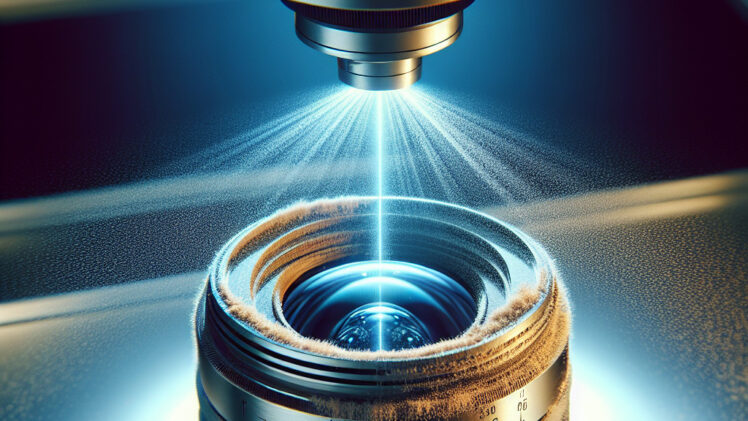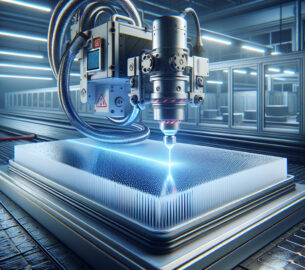- Introduction to laser cleaning for optical lenses
- Comparison of laser cleaning with traditional cleaning methods
- Safety precautions and considerations for laser cleaning
- Challenges and limitations of laser cleaning technology for optical lenses
- Future prospects and advancements in laser cleaning for optical lenses
- Laser cleaning for removing dust and particles from optical lenses
- Laser cleaning for removing coatings and residues from optical lenses
- Laser cleaning for enhancing the safety of optical lenses
Introduction to laser cleaning for optical lenses
Czyszczenie soczewek optycznych jest niezwykle ważne dla utrzymania ich optymalnej wydajności i jakości obrazu. Tradycyjne metody czyszczenia, takie jak używanie płynów do czyszczenia i miękkich ściereczek, mogą być skuteczne, ale często pozostawiają zanieczyszczenia, takie jak smugi, pyłki i odciski palców. W takich przypadkach, czyszczenie laserowe może być idealnym rozwiązaniem.
Czyszczenie laserowe jest nowoczesną technologią, która wykorzystuje wiązkę lasera do usuwania zanieczyszczeń z powierzchni soczewek optycznych. Proces ten polega na skierowaniu wiązki lasera na powierzchnię soczewki, co powoduje odparowanie i usunięcie zanieczyszczeń. Laserowe czyszczenie soczewek optycznych oferuje wiele korzyści, takich jak dokładne i skuteczne usuwanie zanieczyszczeń, minimalne ryzyko uszkodzenia soczewek oraz oszczędność czasu i kosztów.
Jedną z głównych zalet czyszczenia laserowego jest jego precyzja. Wiązka lasera może być skierowana na konkretne obszary soczewki, co pozwala na dokładne usunięcie zanieczyszczeń bez uszkadzania powierzchni soczewki. Ponadto, laserowe czyszczenie jest skuteczne w usuwaniu różnych rodzajów zanieczyszczeń, takich jak tłuste odciski palców, pyłki, smugi czy nawet trudne do usunięcia substancje chemiczne.
Kolejną zaletą czyszczenia laserowego jest minimalne ryzyko uszkodzenia soczewek. Tradycyjne metody czyszczenia, takie jak używanie ściereczek, mogą powodować mikrozarysowania na powierzchni soczewek, co może wpływać na jakość obrazu. Laserowe czyszczenie eliminuje to ryzyko, ponieważ wiązka lasera nie ma fizycznego kontaktu z soczewką, co minimalizuje ryzyko uszkodzenia.
Czyszczenie laserowe jest również bardziej efektywne pod względem czasu i kosztów. Tradycyjne metody czyszczenia mogą wymagać wielokrotnego czyszczenia, aby usunąć wszystkie zanieczyszczenia. Z kolei czyszczenie laserowe jest szybkie i skuteczne, co pozwala zaoszczędzić czas i koszty związane z powtarzającymi się czyszczeniami.
Ważnym aspektem czyszczenia laserowego jest również jego ekologiczność. Tradycyjne metody czyszczenia często wymagają użycia chemikaliów, które mogą być szkodliwe dla środowiska. Czyszczenie laserowe nie wymaga stosowania żadnych substancji chemicznych, co czyni go bardziej przyjaznym dla środowiska.
Podsumowując, czyszczenie laserowe soczewek optycznych jest nowoczesną i skuteczną metodą usuwania zanieczyszczeń z powierzchni soczewek. Oferuje wiele korzyści, takich jak precyzja, minimalne ryzyko uszkodzenia, oszczędność czasu i kosztów, oraz ekologiczność. Dzięki czyszczeniu laserowemu, soczewki optyczne mogą być utrzymane w optymalnym stanie, co przekłada się na lepszą jakość obrazu i wydajność.
Słowa kluczowe: czyszczenie laserowe, soczewki optyczne, zanieczyszczenia, precyzja, ryzyko uszkodzenia, oszczędność czasu i kosztów, ekologiczność.
Frazy kluczowe: czyszczenie laserowe soczewek optycznych, usuwanie zanieczyszczeń z soczewek optycznych, skuteczne czyszczenie soczewek optycznych, precyzyjne czyszczenie laserowe, minimalne ryzyko uszkodzenia soczewek, oszczędność czasu i kosztów czyszczenia laserowego, ekologiczne czyszczenie soczewek optycznych.
Comparison of laser cleaning with traditional cleaning methods
W dzisiejszych czasach istnieje wiele różnych metod czyszczenia, które są stosowane w różnych branżach i dziedzinach. Jednak jedną z najnowocześniejszych i najbardziej efektywnych metod czyszczenia jest czyszczenie laserowe. W porównaniu do tradycyjnych metod czyszczenia, czyszczenie laserowe oferuje wiele korzyści i jest coraz bardziej popularne w różnych dziedzinach, takich jak przemysł, medycyna, archeologia i wiele innych.
Czyszczenie laserowe polega na wykorzystaniu wiązki lasera do usuwania zanieczyszczeń z powierzchni różnych materiałów. Wiązka lasera jest skierowana na powierzchnię, a energia lasera powoduje odparowanie lub odłuszczenie zanieczyszczeń. Ta metoda czyszczenia jest nie tylko skuteczna, ale także nieinwazyjna, co oznacza, że nie uszkadza czyszczonej powierzchni. Ponadto, czyszczenie laserowe jest również bardziej precyzyjne i kontrolowane, co pozwala na dokładne usunięcie zanieczyszczeń bez uszkadzania podłoża.
W porównaniu do tradycyjnych metod czyszczenia, takich jak czyszczenie chemiczne, czyszczenie laserowe ma wiele zalet. Po pierwsze, czyszczenie laserowe jest bardziej ekologiczne, ponieważ nie wymaga stosowania żadnych chemicznych środków czyszczących, które mogą być szkodliwe dla środowiska. Ponadto, czyszczenie laserowe jest również bardziej ekonomiczne, ponieważ nie wymaga zakupu i użycia żadnych dodatkowych środków czyszczących. W dłuższej perspektywie czasowej, czyszczenie laserowe może być bardziej opłacalne, ponieważ nie trzeba inwestować w regularne zakupy środków czyszczących.
Kolejną zaletą czyszczenia laserowego jest jego wszechstronność. Metoda ta może być stosowana do czyszczenia różnych materiałów, takich jak metal, szkło, ceramika, drewno i wiele innych. Niezależnie od rodzaju materiału, czyszczenie laserowe może być skuteczne i precyzyjne. Ponadto, czyszczenie laserowe może być również stosowane do czyszczenia trudno dostępnych miejsc, które są trudne do osiągnięcia za pomocą tradycyjnych metod czyszczenia.
Jednak pomimo wielu zalet, czyszczenie laserowe ma również pewne ograniczenia. Po pierwsze, koszt zakupu i utrzymania urządzenia do czyszczenia laserowego może być wysoki. Ponadto, niektóre materiały mogą być wrażliwe na działanie lasera i mogą ulec uszkodzeniu. Dlatego przed przystąpieniem do czyszczenia laserowego, należy dokładnie zbadać materiał i dostosować parametry lasera do jego specyfikacji.
Podsumowując, czyszczenie laserowe jest nowoczesną i skuteczną metodą czyszczenia, która oferuje wiele korzyści w porównaniu do tradycyjnych metod czyszczenia. Jest bardziej ekologiczne, ekonomiczne, precyzyjne i wszechstronne. Jednak przed przystąpieniem do czyszczenia laserowego, należy dokładnie zbadać materiał i dostosować parametry lasera do jego specyfikacji. W ten sposób można osiągnąć najlepsze rezultaty czyszczenia laserowego.
Słowa kluczowe: czyszczenie laserowe, tradycyjne metody czyszczenia, ekologia, ekonomia, precyzja, wszechstronność.
Frazy kluczowe: czyszczenie laserowe w przemyśle, czyszczenie laserowe w medycynie, czyszczenie laserowe w archeologii, zalety czyszczenia laserowego, ograniczenia czyszczenia laserowego, parametry lasera, skuteczność czyszczenia laserowego.
Safety precautions and considerations for laser cleaning
One of the most important safety precautions for laser cleaning is the use of appropriate personal protective equipment. This includes safety glasses or goggles specifically designed for laser use, as well as gloves and protective clothing to shield the skin from potential laser exposure. The PPE should be selected based on the laser’s wavelength and power output to provide adequate protection.
2. Laser Safety Training:
Operators and technicians involved in laser cleaning should receive comprehensive training on laser safety. They should be educated about the potential hazards associated with laser radiation, the safe operation of laser cleaning equipment, and emergency procedures in case of accidents or injuries. Regular refresher courses should be conducted to ensure that the knowledge is up to date.
3. Laser Classification:
Laser cleaning systems are classified based on their potential hazards. It is crucial to understand the classification of the laser being used and adhere to the safety guidelines specific to that class. This includes maintaining appropriate control measures, such as interlocks, warning labels, and safety devices, to prevent accidental exposure to laser radiation.
4. Controlled Environment:
Laser cleaning should be performed in a controlled environment to minimize the risk of accidents. The workspace should be well-ventilated to prevent the accumulation of hazardous fumes or vapors. Adequate lighting should be provided to ensure clear visibility, and the area should be free from any flammable materials or combustible substances.
5. Laser Beam Control:
Proper control of the laser beam is essential to prevent unintended exposure. The laser cleaning system should be equipped with safety features, such as beam shutters or attenuators, to control the laser output. The beam should be directed away from reflective surfaces or areas where it could potentially cause harm.
6. Risk Assessment:
Before initiating any laser cleaning operation, a thorough risk assessment should be conducted to identify potential hazards and implement appropriate control measures. This includes evaluating the work area, assessing the laser system’s safety features, and considering the potential risks associated with the materials being cleaned.
7. Maintenance and Inspection:
Regular maintenance and inspection of laser cleaning equipment are crucial to ensure its safe and efficient operation. This includes checking for any signs of wear or damage, verifying the calibration of safety features, and promptly addressing any issues or malfunctions.
8. Environmental Considerations:
Laser cleaning can generate hazardous waste, such as debris or residue from the cleaning process. Proper disposal methods should be followed to prevent environmental contamination. Additionally, the use of laser cleaning in sensitive areas, such as historical monuments or artworks, should be carefully evaluated to avoid any potential damage.
Keywords: laser cleaning, safety precautions, personal protective equipment, laser safety training, laser classification, controlled environment, laser beam control, risk assessment, maintenance and inspection, environmental considerations.
Long-tail phrases:
– Importance of personal protective equipment in laser cleaning.
– The significance of laser safety training for operators.
– Understanding laser classification for safe laser cleaning.
– Creating a controlled environment for laser cleaning operations.
– Ensuring proper laser beam control during cleaning processes.
– Conducting a thorough risk assessment before laser cleaning.
– The importance of regular maintenance and inspection of laser cleaning equipment.
– Environmental considerations in laser cleaning operations.
Challenges and limitations of laser cleaning technology for optical lenses
1. Delikatność soczewek optycznych:
Jednym z głównych wyzwań związanych z czyszczeniem laserowym soczewek optycznych jest ich delikatność. Soczewki optyczne są wykonane z różnych materiałów, takich jak szkło optyczne, plastik lub kryształ, które mogą być podatne na uszkodzenia termiczne lub mechaniczne. Laserowe czyszczenie wymaga precyzyjnej kontroli parametrów, takich jak moc lasera, czas naświetlania i odległość od soczewki, aby uniknąć uszkodzeń powierzchniowych.
2. Usuwanie różnych rodzajów zanieczyszczeń:
Laserowe czyszczenie jest skuteczne w usuwaniu różnych rodzajów zanieczyszczeń, takich jak kurz, tłuszcz, plamy czy zacieki. Jednak niektóre zanieczyszczenia mogą być bardziej trudne do usunięcia niż inne. Na przykład, plamy olejowe mogą wymagać większej mocy lasera lub dłuższego czasu naświetlania w porównaniu do zanieczyszczeń na bazie wody. Odpowiednie dostosowanie parametrów lasera jest kluczowe dla skutecznego usuwania różnych rodzajów zanieczyszczeń.
3. Ograniczenia dotyczące wielkości soczewek:
Laserowe czyszczenie może być ograniczone przez rozmiar soczewek optycznych. Soczewki optyczne mogą mieć różne rozmiary i kształty, co może wpływać na możliwość skutecznego czyszczenia za pomocą lasera. Soczewki o większych rozmiarach mogą wymagać większej mocy lasera lub specjalnych urządzeń do czyszczenia, co może zwiększać koszty i skomplikowanie procesu.
4. Ograniczenia dotyczące rodzaju powierzchni soczewek:
Nie wszystkie soczewki optyczne są odpowiednie do czyszczenia laserowego. Niektóre soczewki mogą mieć specjalne powłoki optyczne, które są wrażliwe na działanie lasera. Czyszczenie laserowe może uszkodzić lub zmienić właściwości powłok, co może prowadzić do pogorszenia jakości obrazu lub zmniejszenia wydajności soczewek. W takich przypadkach konieczne jest zastosowanie innych metod czyszczenia, które nie naruszają powłok optycznych.
5. Koszty i dostępność technologii:
Laserowe czyszczenie soczewek optycznych może być kosztowne ze względu na wymaganą specjalistyczną aparaturę i wysoką precyzję. Nie wszystkie laboratoria czy zakłady optyczne mają dostęp do tej technologii, co może ograniczać jej powszechne stosowanie. Ponadto, koszty utrzymania i konserwacji urządzeń laserowych mogą być znaczące, co może wpływać na dostępność tej technologii dla mniejszych przedsiębiorstw.
Podsumowanie:
Technologia czyszczenia laserowego dla soczewek optycznych jest skutecznym sposobem usuwania zanieczyszczeń, ale niesie ze sobą pewne wyzwania i ograniczenia. Delikatność soczewek, różne rodzaje zanieczyszczeń, ograniczenia dotyczące wielkości i rodzaju powierzchni soczewek, a także koszty i dostępność technologii są głównymi czynnikami, które należy wziąć pod uwagę przy stosowaniu czyszczenia laserowego dla soczewek optycznych.
Słowa kluczowe: laserowe czyszczenie, soczewki optyczne, wyzwania, ograniczenia, delikatność, zanieczyszczenia, wielkość soczewek, rodzaj powierzchni, koszty, dostępność.
Frazy kluczowe: technologia czyszczenia laserowego dla soczewek optycznych, skuteczność czyszczenia laserowego soczewek optycznych, uszkodzenia termiczne i mechaniczne soczewek optycznych, różne rodzaje zanieczyszczeń na soczewkach optycznych, czyszczenie plam olejowych na soczewkach optycznych, ograniczenia czyszczenia laserowego dla soczewek optycznych, specjalne powłoki optyczne na soczewkach optycznych, koszty i dostępność technologii czyszczenia laserowego soczewek optycznych.
Future prospects and advancements in laser cleaning for optical lenses
Laser cleaning technology has come a long way in recent years, offering several advantages over traditional cleaning methods. One significant advancement is the development of ultrafast lasers, which emit extremely short pulses of light. These lasers can remove contaminants from optical lenses without causing any damage. The short pulse duration prevents the transfer of heat to the lens, minimizing the risk of thermal damage. Additionally, ultrafast lasers can precisely target specific areas, ensuring thorough cleaning without affecting the lens surface.
Another advancement in laser cleaning technology is the use of different laser wavelengths. Different materials and contaminants require specific wavelengths for effective cleaning. By utilizing lasers with various wavelengths, it is possible to tailor the cleaning process to the specific needs of different types of lenses. This flexibility allows for efficient removal of contaminants, including dust, oils, fingerprints, and even coatings, without compromising the lens quality.
Furthermore, advancements in laser beam delivery systems have made laser cleaning more accessible and practical. Fiber optic delivery systems enable the laser beam to be directed precisely to the desired location, even in hard-to-reach areas. This ensures that the entire lens surface is thoroughly cleaned, leaving no residue behind. Additionally, automated laser cleaning systems have been developed, allowing for faster and more efficient cleaning processes, particularly in industrial settings.
Future Prospects:
The future prospects for laser cleaning in optical lens maintenance are promising. As technology continues to advance, we can expect further improvements in laser cleaning systems. One area of development is the integration of artificial intelligence (AI) and machine learning algorithms into laser cleaning systems. AI can analyze the lens surface and identify the type and location of contaminants, enabling the laser to adjust its parameters accordingly for optimal cleaning. This level of automation and intelligence will revolutionize the lens cleaning process, making it more efficient and precise.
Another future prospect is the miniaturization of laser cleaning systems. As the size of lasers and beam delivery systems decreases, it will become possible to incorporate laser cleaning technology directly into optical devices. This would eliminate the need for separate cleaning procedures and ensure continuous maintenance of lens surfaces. Miniaturized laser cleaning systems could be integrated into cameras, microscopes, and other optical instruments, enhancing their performance and longevity.
Keywords: laser cleaning, optical lenses, advancements, ultrafast lasers, pulse duration, laser wavelengths, beam delivery systems, artificial intelligence, machine learning, miniaturization, continuous maintenance.
Long-tail phrases:
1. Advancements in laser cleaning technology for optical lenses.
2. The impact of ultrafast lasers on lens cleaning.
3. Tailoring laser cleaning to specific lens requirements.
4. The role of fiber optic delivery systems in laser cleaning.
5. Automation and artificial intelligence in laser cleaning for lenses.
6. Miniaturized laser cleaning systems for integrated lens maintenance.
Laser cleaning for removing dust and particles from optical lenses
The process of laser cleaning involves the use of a laser system that emits a focused beam of light. This laser beam is directed towards the lens surface, where it interacts with the contaminants. The high energy of the laser beam causes the contaminants to vaporize or sublimate, turning them into gas or solid particles. These particles are then removed from the lens surface using a vacuum or compressed air system.
Laser cleaning offers several advantages over traditional cleaning methods. Firstly, it is a dry cleaning process, eliminating the need for any liquid solvents or cleaning agents. This makes it environmentally friendly and reduces the risk of chemical residue on the lens. Secondly, laser cleaning is a highly precise technique that can target specific areas of the lens, ensuring thorough cleaning without affecting the surrounding components. It can remove even the smallest particles, including dust, fingerprints, and oil smudges, which are often difficult to remove using conventional methods.
Furthermore, laser cleaning is a fast and efficient process. It can clean lenses within seconds or minutes, depending on the size and complexity of the lens. This makes it ideal for high-volume production environments where quick turnaround times are essential. Additionally, laser cleaning is a non-destructive technique that does not alter the optical properties of the lens. It preserves the lens’s clarity, transparency, and refractive index, ensuring that it performs optimally.
Laser cleaning is particularly beneficial for removing stubborn contaminants that are challenging to eliminate using other methods. For example, some lenses may have coatings or delicate surfaces that require special care. Laser cleaning can effectively remove contaminants from these surfaces without causing any damage. It is also useful for cleaning lenses with complex geometries or hard-to-reach areas, ensuring a thorough and comprehensive cleaning process.
In conclusion, laser cleaning is a highly advanced and efficient method for removing dust and particles from optical lenses. Its non-contact and non-abrasive nature make it a safe and reliable cleaning technique. With its precision, speed, and effectiveness, laser cleaning ensures that optical lenses maintain their optimal performance and longevity. By incorporating laser cleaning into lens maintenance routines, industries can enhance image quality, reduce downtime, and improve overall productivity.
Keywords: laser cleaning, optical lenses, dust removal, particle removal, non-contact cleaning, non-abrasive cleaning, high-intensity laser beams, image quality, lens surface, gentle cleaning, scratching, longevity, performance, dry cleaning, environmentally friendly, precise cleaning, targeted cleaning, fast cleaning, efficient cleaning, non-destructive cleaning, optical properties, stubborn contaminants, coatings, delicate surfaces, complex geometries, thorough cleaning, comprehensive cleaning, maintenance routines.
Long-tail phrases: laser cleaning for optical lenses, removing dust and particles from lenses, non-contact cleaning technique, advantages of laser cleaning, precision cleaning for optical lenses, environmentally friendly lens cleaning, fast and efficient lens cleaning, non-destructive cleaning method, removing stubborn contaminants from lenses, comprehensive lens cleaning process.
Laser cleaning for removing coatings and residues from optical lenses
One of the main advantages of laser cleaning is its ability to remove a wide range of coatings and residues. Whether it’s dust, oils, fingerprints, or even stubborn coatings like anti-reflective films, laser cleaning can effectively eliminate them without leaving any trace behind. This is particularly important for optical lenses, as even the slightest residue can significantly impact their performance and image quality.
Moreover, laser cleaning is a fast and cost-effective solution compared to traditional cleaning methods. Manual cleaning techniques often involve the use of solvents, brushes, or ultrasonic baths, which can be time-consuming and require additional resources. Laser cleaning, on the other hand, is a highly automated process that can be completed within seconds, reducing downtime and increasing productivity.
Another significant advantage of laser cleaning is its ability to clean lenses without disassembling them. In many cases, optical lenses are part of complex systems or devices, making disassembly impractical or even impossible. Laser cleaning allows for in-situ cleaning, meaning the lens can be cleaned while still in its housing or assembly. This not only saves time but also minimizes the risk of damage during disassembly and reassembly.
Furthermore, laser cleaning is a safe and environmentally friendly method. Unlike traditional cleaning methods that often involve the use of harsh chemicals or solvents, laser cleaning is a dry process that does not produce any hazardous waste. It is also a non-contact method, eliminating the risk of physical damage to the lens or the operator.
In terms of precision, laser cleaning offers unparalleled control and accuracy. The laser beam can be precisely focused on the desired area, ensuring that only the coating or residue is removed while leaving the lens surface intact. This level of precision is crucial for maintaining the optical properties of the lens and ensuring consistent performance.
In conclusion, laser cleaning is a highly efficient, precise, and cost-effective method for removing coatings and residues from optical lenses. Its ability to remove a wide range of contaminants, its non-contact nature, and its in-situ cleaning capabilities make it an ideal solution for various industries. With laser cleaning, optical lenses can be restored to their original clarity and performance, ensuring optimal imaging and accurate measurements.
Keywords: laser cleaning, optical lenses, coatings, residues, non-contact, non-abrasive, vaporize, ablate, performance, image quality, fast, cost-effective, in-situ cleaning, precision, safe, environmentally friendly.
Long-tail phrases: laser cleaning technology for removing coatings from optical lenses, non-abrasive method for removing residues from optical lenses, advantages of laser cleaning for optical lenses, in-situ laser cleaning for optical lenses, precision and accuracy of laser cleaning for optical lenses, safe and environmentally friendly cleaning method for optical lenses.
Laser cleaning for enhancing the safety of optical lenses
One of the key advantages of laser cleaning is its ability to remove contaminants without causing any physical damage to the lens. Traditional cleaning methods, such as wiping or using solvents, can scratch or degrade the lens surface, leading to reduced optical performance and potential safety risks. Laser cleaning eliminates the need for physical contact, minimizing the risk of damage and ensuring that the lens maintains its original quality and functionality.
Furthermore, laser cleaning is a highly efficient process that can be completed in a short amount of time. Unlike traditional cleaning methods that require manual labor and multiple cleaning steps, laser cleaning can be automated and performed rapidly. This not only saves time but also reduces the overall cost of lens maintenance. Additionally, laser cleaning is a dry process, eliminating the need for water or chemicals, which further contributes to its efficiency and environmental friendliness.
In addition to enhancing the safety of optical lenses, laser cleaning also improves their performance. Contaminants on the lens surface can cause light scattering, reducing the clarity and resolution of the lens. By removing these contaminants, laser cleaning restores the lens’s optical properties, ensuring that it delivers high-quality images and accurate measurements. This is particularly important in industries such as healthcare and manufacturing, where precise and reliable optical systems are essential for diagnostics, quality control, and research purposes.
To summarize, laser cleaning is a highly effective method for enhancing the safety and performance of optical lenses. Its non-contact and non-abrasive nature ensure that the lens remains undamaged during the cleaning process, while its efficiency and precision save time and cost. By removing contaminants, laser cleaning restores the lens’s optical properties, ensuring optimal performance in various applications. As technology continues to advance, laser cleaning is expected to become even more sophisticated, further improving the safety and functionality of optical lenses.
Keywords: laser cleaning, optical lenses, safety, contaminants, performance, non-contact, non-abrasive, efficiency, precision, technology.
Long-tail phrases:
– Laser cleaning for optical lens safety enhancement
– Non-contact laser cleaning for lens maintenance
– Benefits of laser cleaning for optical lenses
– Environmental-friendly lens cleaning with lasers
– Laser cleaning for improved lens performance
- Laser cleaning for removing contaminants from plastic surfaces - 26 April 2024
- Laser cleaning for removing contaminants from optical lenses - 7 February 2024
- Technology as a way to reduce drug counterfeiting - 7 February 2024







